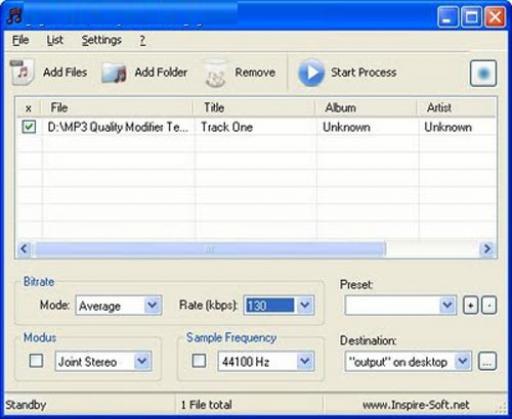

Select the Chain we have just created and load all files you need with "Apply to files.". When done leave this window with OK to open "File -> Apply Chain.". Important: we always need to also add the effect "Export MP3" (or any other export format) for saving the resulting conversion to disk. Then choose the effect and it's parameters to insert to the chain (here shown for default values and the Normalize effect). In the now opening window press the Add button on the bottom left to insert a new chain (give it a sensible name): This is done with "File -> Edit Chains.".

To do so we first have to define a "Chain" containing the effects we want to apply. With Audacity we can easily batch process files to apply conversions or effects to many files in a list.
#Reduce mp3 gain install#
After that, you need to run sudo apt-get -f install to correct some dependencies issues. deb file for 14.04 (the latest) from here. Noted lately the binary file is replaygainĪlternatively, get the. To install python-rgain from the terminal, run the command sudo apt-get install python-rgain Also, it allows you to view existing Replay Gain information in any of those file types). Note: That package was removed on purpose on ubuntu 15.04.ĭebian proposes the python-rgain package as replacement (The advantage is that 'replaygain' supports several file formats, namely Ogg Vorbis, Flac, WavPack and MP3. There is no quality lost in the change because the program adjusts the mp3 file directly, without decoding and re-encoding. Instead, it does some statistical analysis to determine how loud the file actually sounds to the human ear. Mp3gain does not just do peak normalization, as many normalizers do. The script defaults to EBU R128 normalization with two passes, but peak and RMS normalization are also supported.įor details, run ffmpeg-normalize -h or see the README file.Take a look mp3gain which for me is even better than normalize-audio mp3gain -r *.mp3Īnother useful version could be the -c which prevent to ask if you want to do the changes for many files: mp3gain -c -r *.mp3 To automate the normalization processes with ffmpeg without having to manually perform two passes, and run normalization on multiple files (including video), you can also use the ffmpeg-normalize Python program via pip install ffmpeg-normalize. See the loudnorm filter documentation for more. However, it is recommended to run the normalization with two passes, extracting the measured values from the first run, then using the values in a second run with linear normalization enabled.

This is recommended for most applications, as it will lead to a more uniform loudness level compared to simple peak-based normalization. If you want to normalize the (perceived) loudness of the file, use the loudnorm filter, which implements the EBU R128 algorithm:įfmpeg -i input.wav -filter:a loudnorm output.wav then calculate the required offset, and use the volume filter as shown above.

Read the output values from the command line log: To normalize the volume to a given peak or RMS level, the file first has to be analyzed using the volumedetect filter:įfmpeg -i input.wav -filter:a volumedetect -f null /dev/null To set or otherwise normalize the volume of a stream, see the sections below. Note that the volume filter only adjusts the volume. To reduce the volume, use a negative value:įfmpeg -i input.wav -filter:a "volume=-5dB" output.wav To increase the volume by 10dB:įfmpeg -i input.wav -filter:a "volume=10dB" output.wav If we want our volume to be half of the input volume:įfmpeg -i input.wav -filter:a "volume=0.5" output.wavįfmpeg -i input.wav -filter:a "volume=1.5" output.wav To change the audio volume, you may use FFmpeg's volume audio filter. Audio Volume Manipulation Changing volume


 0 kommentar(er)
0 kommentar(er)
